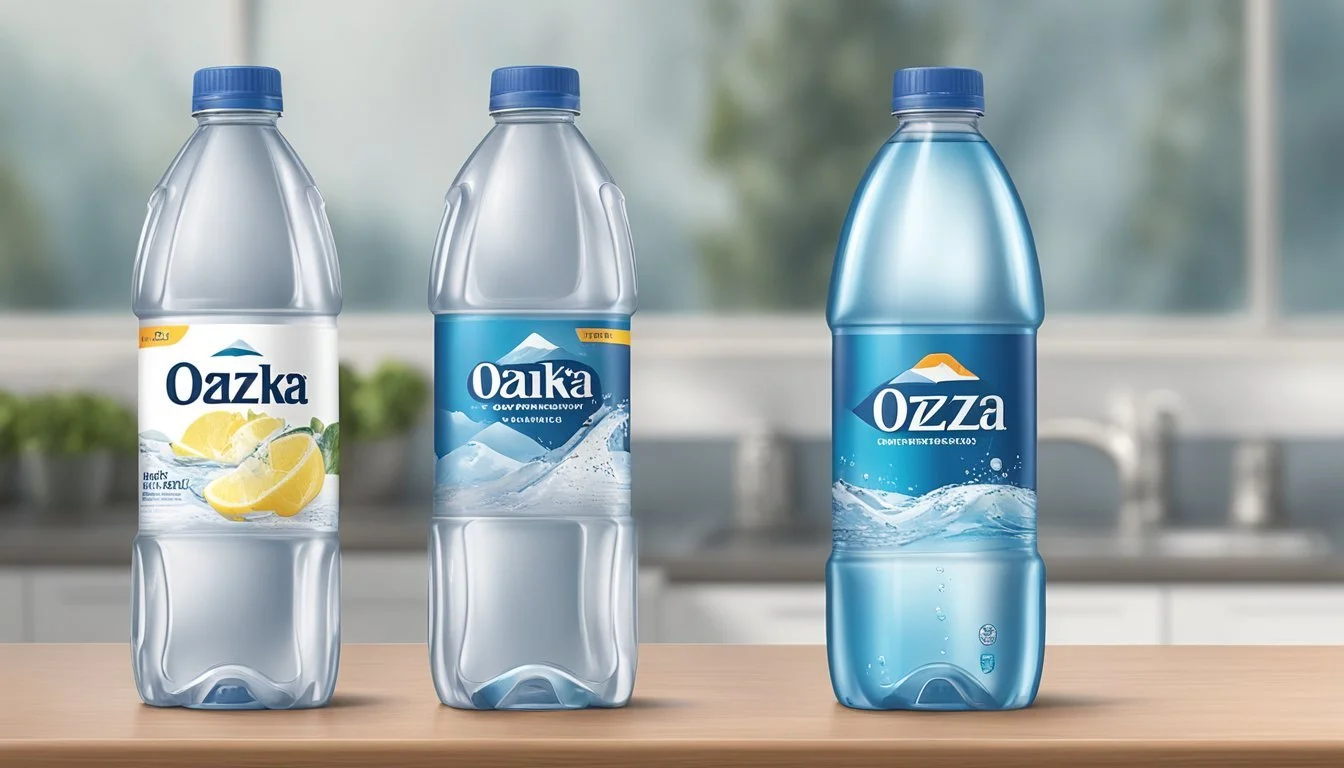Ozarka vs. Path
Comparing Bottled Water Quality and Benefits
When choosing between Ozarka and Path bottled water, consumers often look for factors such as taste, quality, and cost. Ozarka, sourced locally from Texas, is known for its consistent quality and affordable pricing. Path, on the other hand, emphasizes sustainability with its reusable aluminum bottles and clean, crisp taste.
In a direct comparison, Path offers a more environmentally friendly option with its reusable packaging, while Ozarka provides a reliable and cost-effective choice. This distinction makes Path appealing for those prioritizing eco-consciousness and Ozarka attractive for budget-focused buyers.
Understanding these differences can help consumers make an informed decision tailored to their specific needs and preferences.
Overview of the Bottled Water Industry
The bottled water industry is a rapidly expanding market driven by consumer preferences for convenience and perceived quality. Regulatory standards play a crucial role in ensuring the safety and purity of bottled water products.
Evolving Consumer Demand
Consumer demand for bottled water has surged due to increasing health consciousness and the desire for convenience. Many brands promote their products as pure and beneficial for health, appealing to a wide demographic.
Reports show that innovations in packaging and marketing are also key drivers of growth.
The ability to source water from specific locations, as Ozarka does from Texas, can influence consumer choice based on perceived local quality.
Bottled water's rise also correlates with a decline in carbonated soft drink consumption, highlighting a shift toward healthier options.
Regulatory Standards and Safety
Bottled water quality is governed by stringent regulatory standards to ensure consumer safety. In the United States, the Food and Drug Administration (FDA) oversees bottled water regulations, requiring compliance with the same quality standards as public water systems regulated by the Environmental Protection Agency (EPA).
Companies must adhere to rigorous testing for contaminants and proper labeling, ensuring transparency for consumers.
Regular inspections and monitoring processes are in place to prevent contamination and maintain the natural mineral composition of the water.
These standards help build consumer trust in the safety and quality of bottled water products.
Comparing Ozarka and Path
Both Ozarka and Path offer bottled water options with distinct characteristics. Examining their brand history, origin, water source, and bottling process provides insights into their quality and unique attributes.
Brand History and Origin
Ozarka has a long-standing presence in the bottled water industry. Originating in Texas, Ozarka focuses on providing natural spring water from local sources. This local focus has helped build a strong brand identity in the region.
Path is a newer brand in the market, emphasizing sustainability with its reusable aluminum bottles. Originating from California, Path aims to reduce single-use plastic waste, promoting environmentally friendly practices.
Source and Natural Spring Water
Ozarka sources its water from natural springs in Texas. These springs offer naturally occurring minerals that contribute to the water's distinctive taste. The local sourcing ensures consistent quality and supports regional eco-systems.
Path sources its water from sustainable locations in California. The focus is on maintaining minimal environmental impact while ensuring the water remains pure and free of contaminants. Unlike Ozarka, Path emphasizes eco-conscious practices in its sourcing methods.
Bottling Process and Quality
Ozarka utilizes a rigorous bottling process to ensure its water retains its natural qualities. The water undergoes minimal processing, preserving its natural taste and mineral content. Quality control measures are stringent, ensuring each bottle meets high standards.
Path employs a sophisticated bottling process focused on sustainability. The reusable aluminum bottles are durable and designed to reduce waste. The water is filtered to maintain purity and taste, with quality checks in place to guarantee safety and satisfaction.
These key areas highlight the primary differences and strengths of Ozarka and Path, providing a clear basis for comparison.
Water Quality and Composition
Examining the quality of Ozarka and Path bottled waters involves analyzing their pH levels, mineral content, and any presence of contaminants. Each of these factors can influence taste, health benefits, and safety for consumption.
PH Levels and Alkalinity
Ozarka and Path bottled waters have distinct pH levels that can affect their taste and potential health benefits.
Ozarka typically boasts a neutral to slightly alkaline pH, usually around 7.0 to 7.8, which can be appealing for those preferring smoother-tasting water.
Path, on the other hand, often highlights its alkaline properties more prominently, with pH levels ranging from 8.0 to 9.5. Higher pH and alkalinity may counteract acidity in the body, which some consumers find beneficial.
Mineral Content Analysis
The mineral composition of Ozarka and Path bottled waters is crucial for their taste and possible health benefits.
Ozarka sources its water from springs in Texas, providing a natural mix of minerals including calcium, magnesium, and potassium. These minerals contribute to the water's crisp and refreshing quality.
Path water, often marketed as premium alkaline water, typically includes added electrolytes and minerals designed to enhance hydration. This may include minerals such as sodium bicarbonate, potassium bicarbonate, and calcium chloride.
Here's a comparison table for minerals:
Mineral Ozarka (mg/L) Path (mg/L) Calcium 20-30 5-15 Magnesium 3-10 1-5 Potassium <1 5-10
Presence of Contaminants
The presence of contaminants such as heavy metals and arsenic can significantly impact water safety.
Consumer Reports has tested various bottled water brands for contaminants.
Ozarka has been found to be free from harmful levels of PFAS and heavy metals, maintaining a reputation for clean and safe drinking water.
Path water is similarly monitored for contaminants and is promoted as containing negligible levels of harmful substances. This effort ensures that Path maintains its premium image and delivers safe hydration.
In summary, both Ozarka and Path focus on offering safe, high-quality water, with careful attention to pH levels, mineral content, and contaminant-free standards.
Health and Hydration Benefits
Ozarka and Path bottled waters offer different benefits in terms of hydration and overall health. This section covers how they help with hydration and adds minerals to their water.
Hydration and Electrolytes
Both Ozarka and Path provide effective hydration. Path water is often enhanced with electrolytes like potassium and sodium, which aid in maintaining fluid balance and muscle function. These electrolytes are particularly beneficial for athletes or individuals involved in intensive physical activities.
Ozarka, sourced from natural springs, delivers hydration with a fresh taste. Though not all Ozarka varieties include added electrolytes, the natural mineral content, including calcium and magnesium, supports hydration.
Electrolytes influence hydration quality by assisting in water absorption at the cellular level. Without adequate electrolytes, even ample water intake might not fully hydrate the body.
Health Benefits of Mineral Water
Mineral water like Ozarka contains calcium, magnesium, and trace amounts of other minerals naturally present from its spring source. Calcium supports bone health, while magnesium benefits muscle function and enzymatic processes. Regular consumption can contribute to meeting daily mineral requirements.
Path water, sometimes fortified with additional minerals, also aims to offer health benefits. Adding electrolytes like potassium aids in heart function and maintaining balanced fluid levels.
Understanding the mineral content can help consumers choose water that fits their health needs. Both options generally provide benefits beyond basic hydration, making them suitable for varied dietary and health requirements.
Consumer Experience
Consumer preference for bottled water can swiftly vary based on factors like taste, aftertaste, packaging, and convenience. For both Ozarka and Path, these elements form the crux of their appeal or criticism among customers.
Taste and Aftertaste
Ozarka is known for its crisp and clean taste, derived from naturally occurring spring water sourced in Texas. The water's mineral content subtly influences its flavor profile, making it a favorite for those who favor a natural taste. Some consumers mention a slight mineral tang as part of their experience, which can enhance the taste for some or be off-putting for others.
Path, on the other hand, packages its water in refillable aluminum bottles, which can influence the taste and aftertaste differently when compared to plastic or glass bottles. Many appreciate the absence of any plasticky taste, and the water remains neutral and pure. There is less mention of mineral tang, with the focus being on a clean and consistent flavor. The aftertaste has been described as non-distracting, ensuring a smooth hydrated feel.
Packaging and Convenience
Ozarka typically utilizes plastic bottles, which are lightweight and easy to transport but have environmental concerns. The convenience of the bottle shape fits standard cup holders and is practical for on-the-go hydration. Ozarka also comes in various sizes, catering to different needs and consumption rates.
Path aims to revolutionize the bottled water market with its sleek, reusable aluminum bottles. The durability and eco-friendly aspect of the packaging appeal to environmentally conscious consumers. Although slightly heavier than their plastic counterparts, the bottles are designed for multiple uses, promoting sustainability. The aluminum insulation helps maintain water temperature, adding to the convenience.
Both Ozarka and Path present unique advantages and cater to diverse consumer preferences, reflecting their distinct approaches to enhancing the customer experience through taste and packaging choices.
Marketplace Alternatives
In comparing bottled water brands, understanding how Ozarka and Path stack up against their competitors like Fiji, Voss, and Evian is crucial for making an informed decision. This section will delve into the comparative qualities and market position of these brands.
Comparison with Other Brands
Ozarka sources its water from springs in Texas, offering a local and natural taste. In contrast, Path is known for its reusable aluminum bottles, stressing environmental sustainability.
Fiji and Evian provide premium, mineral-rich water from exotic locations, which significantly impacts their price points. Essentia promotes alkaline water with ionization for purported health benefits, which differs from the natural spring offerings of Ozarka and Path.
Pure Life and Nestlé Pure Life target budget-conscious consumers, with water sourced and purified from various locations. Dasani and Aquafina, often criticized for their municipal sources, still dominate the market due to branding and availability.
Smartwater differentiates itself with its vapor-distilled process and added electrolytes, appealing to wellness-focused consumers. Poland Spring emphasizes its natural springs in the Northeastern United States.
Position in the Market
Ozarka maintains a strong regional presence in Texas and surrounding areas, tapping into local preferences with its spring water. It competes with Poland Spring and Mountain Valley in the natural spring water category.
Path leverages its sustainable packaging, positioning itself against traditional single-use bottle brands. This eco-friendly angle targets environmentally conscious consumers, similar to how Icelandic Glacial markets its carbon-neutral certified operations.
Brands like Perrier and Acqua Panna occupy the premium segment, offering unique, high-end drinking experiences. Conversely, brands such as Pure Life and Dasani focus on affordability and distribution, securing massive market shares through extensive retail networks.
Both Ozarka and Path carve out specific niches, with Ozarka focusing on regional loyalty and natural sourcing, while Path champions sustainability and reuse, differentiating them from competitors with distinct market strategies.
More About Ozarka
Mountain Valley Spring Water vs Ozarka: Which Bottled Water is Better?
Ozarka vs Kirkland Signature: Which Bottled Water is Better?
Ozarka vs Richard's Rainwater: Which Bottled Water is Better?
Ozarka vs Whole Foods Italian Still Mineral water: Which Bottled Water is Better?




